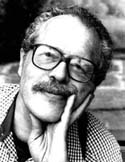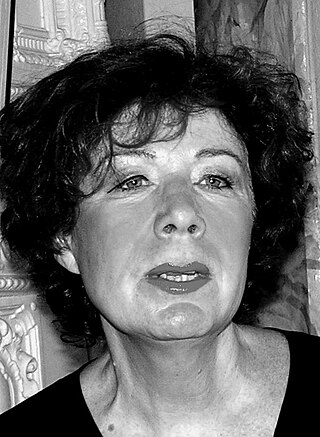Related Research Articles

Fluxus was an international, interdisciplinary community of artists, composers, designers, and poets during the 1960s and 1970s who engaged in experimental art performances which emphasized the artistic process over the finished product. Fluxus is known for experimental contributions to different artistic media and disciplines and for generating new art forms. These art forms include intermedia, a term coined by Fluxus artist Dick Higgins; conceptual art, first developed by Henry Flynt, an artist contentiously associated with Fluxus; and video art, first pioneered by Nam June Paik and Wolf Vostell. Dutch gallerist and art critic Harry Ruhé describes Fluxus as "the most radical and experimental art movement of the sixties".

Dick Higgins was an American artist, composer, art theorist, poet, publisher, printmaker, and a co-founder of the Fluxus international artistic movement. Inspired by John Cage, Higgins was an early pioneer of electronic correspondence. Higgins coined the word intermedia to describe his artistic activities, defining it in a 1965 essay by the same name, published in the first number of the Something Else Newsletter. His most notable audio contributions include Danger Music scores and the Intermedia concept to describe the ineffable inter-disciplinary activities that became prevalent in the 1960s.

James Tenney was an American composer and music theorist. He made significant early musical contributions to plunderphonics, sound synthesis, algorithmic composition, process music, spectral music, microtonal music, and tuning systems including extended just intonation. His theoretical writings variously concern musical form, texture, timbre, consonance and dissonance, and harmonic perception.

Alvin Augustus Lucier Jr. was an American experimental composer and sound artist. A long-time music professor at Wesleyan University in Middletown, Connecticut, Lucier was a member of the influential Sonic Arts Union, which also included Robert Ashley, David Behrman, and Gordon Mumma. Much of Lucier's work explores psychoacoustic phenomena and the physical properties of sound.

Alvin Curran is an American composer, performer, improviser, sound artist, and writer. He was born in Providence, Rhode Island, and lives and works in Rome, Italy. He is the co-founder, with Frederic Rzewski and Richard Teitelbaum, of Musica Elettronica Viva, and a former student of Elliott Carter. Curran's music often makes use of electronics and environmental found sounds. He was a professor of music at Mills College in California until 2006 and now teaches privately in Rome and sporadically at various institutions.

Evan Ziporyn is an American composer of post-minimalist music with a cross-cultural orientation, drawing equally from classical music, avant-garde, various world music traditions, and jazz. Ziporyn has composed for a wide range of ensembles, including symphony orchestras, wind ensembles, many types of chamber groups, and solo works, sometimes involving electronics. Balinese gamelan, for which he has composed numerous works, has compositions. He is known for his solo performances on clarinet and bass clarinet; additionally, Ziporyn plays gender wayang and other Balinese instruments, saxophones, piano & keyboards, EWI, and Shona mbira.

John Stanley Body was a New Zealand composer, ethnomusicologist, photographer, teacher, and arts producer. As a composer, his work comprised concert music, music theatre, electronic music, music for film and dance, and audio-visual gallery installations. A deep and long-standing interest in the music of non-Western cultures – particularly South-East Asian – influenced much of his composing work, particularly his technique of transcribing field recordings. As an organiser of musical events and projects, Body had a significant impact on the promotion of Asian music in New Zealand, as well as the promotion of New Zealand music within the country and abroad.

Alfred Earl "Al" Hansen was an American artist. He was a member of Fluxus, a movement that originated on an artists' collective around George Maciunas.

Chaim Moshe Tzadik Palestine, known professionally as Charlemagne Palestine, is an American visual artist and musician. He has been described as being one of the founders of New York school of minimalist music, first initiated by La Monte Young, Terry Riley, Philip Glass, Steve Reich, and Phil Niblock, although he prefers to call himself a maximalist.
Geoffrey Hendricks was an American artist associated with Fluxus since the mid 1960s. He was professor of art at Douglass College, Rutgers University, where he taught from 1956 to 2003 and was associated with Fluxus at Rutgers University, Allan Kaprow, Roy Lichtenstein, and Lucas Samaras during the 1960s.
Philip Krumm is an American composer who was "a pioneer of modal, repetitive pattern music". Krumm studied orchestration and composition with Raymond Moses in high school, with Frank Sturchio at Saint Mary's University, with Ross Lee Finney at University of Michigan, and with Karlheinz Stockhausen at the University of California at Davis.

Gino Robair is an American composer, improvisor, drummer, percussionist, and magazine editor. In his own music work, he plays prepared/modified percussion, analog synthesizer, ebow and prepared piano, theremin, and bowed objects. Robair resides in the San Francisco Bay Area, California.
Zaj was an experimental music and performance art group formed in 1959 in Milan, Italy by composers and intermedia artists Walter Marchetti and Juan Hidalgo, with the support of the American composer John Cage. The group received major contributions by different artists from the Spanish avant-garde scene, notably from the writer and diplomat José Luis Castillejo and from the interdisciplinary artist Esther Ferrer. During the 1960s, members of Zaj took part in different Fluxus events organised by George Maciunas. With the help of John Cage and his agent Mimi Johnson, Zaj also toured in the United States in the late 1970s. The group officially disbanded in 1993.
Juan Hidalgo Codorniu was a Spanish composer, poet, an action and visual artist.

Thollem McDonas is an American pianist, improviser, composer, singer-songwriter, touring performer, musical educator, and social critic. His musical compositions and performances have ranged from classical, and free jazz, to experimental and punk rock. He has toured North America and Europe since 2006, performing solo works and collaborating with an array of musicians, dancers, dance companies and filmmakers.

Plus-Minus, 2 × 7 pages for realisation, is a composition for one or several performers by Karlheinz Stockhausen, first written in 1963 and redrafted in 1974. It is Nr. 14 in the composer's catalogue of works, and has a variable performing length that depends on the version worked out from the given materials. The score is dedicated to Mary Bauermeister.
Giuseppe Chiari was an avant-garde Florentine conceptual artist and experimental musician active in Neo-Dada circles, specifically the Fluxus art movement. Chiari was a supporter of intermedia work conducted between music, speech, gesture and image.

Gabriel Vicéns is a Puerto Rican guitarist, composer, producer, bandleader, educator, and visual artist currently based in New York City.

Ann Noël is a British artist associated with the Fluxus movement. Noël has lived and worked in Berlin since 1980 and was married to the American artist and poet Emmett Williams. Noël's artistic practice integrates performance, installation, painting, graphic design, printmaking, and photography.
Setola di Maiale is an Italian record label founded by Stefano Giust and Paolo De Piaggi in 1993.
References
- ↑ Elke Gruhn (June 9, 2019). ""Fluxus is a big ship on which to take a great excursion"". Schirn Mag. Retrieved September 29, 2024.
- ↑ "Writers and Editors War Tax Protest" January 30, 1968 New York Post
- Living Music. Charlie Morrow. SoHo Weekly News . Philip Corner's music grows out of a seriousness of purpose that seems, over and over again, to draw people deep into the events he creates. January 24, 1974. New York